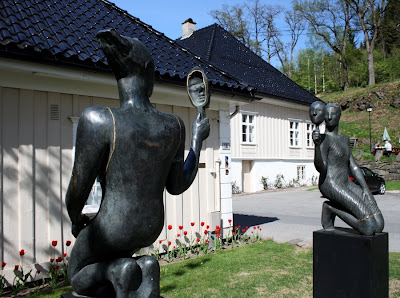
The famous paintings by Edvard Munch (1863-1944); Skrik (The Scream) and Madonna are finally back on the walls in the Munch museum in Oslo. After they were stolen and missing for over 2 years, conservation specialists have worked at restoring the paintings since August 2006. The paintings are now in an exhibition at the Munch Museum, lasting until September 26th.
Together with Mark Wilkinson, I went to the Munch Museum a few days ago to see the exhibition of Scream/Madonna and other paintings by Norway's most famous painter.
Some of you commented on the background for Munch painting The Scream. First of all, Munch's life and art were greatly influenced by the suffering and death he experienced in near family when he was a child; both his mother and one sister died of tuberculosis and Edvard Munch was himself often sick in his childhood. This quote explains in Munch's own words what inspired him to paint The Scream:
I was walking along the road with two friends.
The sun was setting,
and I began to be afflicted with a sense of melancholy.
Suddenly the sky became blood-red.
I stopped and leaned against a fence, feeling dead-tired,
and stared at the flaming clouds that hung, like blood and a sword,
over the blue-black fjord and the city.
My friends walked on.
I stood riveted, trembling with fright.
And I felt a loud, unending scream piercing nature.
(Edvard Munch 1892)
Below Ekebergåsen, where he was walking, there was (and still is) a mental asylum. He might have heard one of the patients scream, but that is just a guess.

The version of the Madonna in the Munch Museum is painted on canvas and is dated 1893-94. There are four additional painted versions of the image. The National Gallery Oslo and the Hamburger Kunsthalle each have one, while two are in private collections. In 1895 Munch made a lithographic version of Madonna, with a decorative frame depicting spermatozoa and an embryo. Several poetic texts related to Madonna underscore the intimate relationship between love and death:
When the paintings were found after being missing for 2 years, the concerns were whether the two paintings were severely damaged. Luckily they were in "better shape" than feared. Mark and I discussed what Munch would have thought of the theft of his paintings and the damages done to them. It's of course impossible to know, but Mark sent me these quotes and thoughts in an email:...Now life is shaking hands with death
The chain that binds together the thousand generations
of dead with the thousand generations yet to be born
has been tied...
No more interiors should be painted, no people reading and women knitting. They should be living people who breathe, feel, suffer and love. (From Munch's diary 1889)
Munch's paintings were also to have life, to feel and to suffer. He would paint outdoors at all times of the year at his home in Ekely, in an outdoor studio. Finished paintings were hung on the walls there and left out unprotected. He said his paintings could only improve by that sort of treatment.
Oh well, that will be all right when it has stood there for a while and has had time to mature. The colours live a remarkable life of their own after they have been applied to the canvas. Some reconcile themselves to one another, others just clash, and then they go together either to perdition or to eternal life. Just wait until they have weathered a few showers of rain, a few scratches with nails, or something of the sort, and have knocked about all over the world in every kind of miserable, battered, and far from air- or water-tight packing case. Oh yes, that will turn out all right ... when it has developed a few slight flaws it will be quite presentable.
I think, therefore, that any sentiment regarding the damage done to the stolen paintings is quite unfounded. In some ways I think Munch would have been happy that the paintings have now had an added injection of life.
The Munch Museum
Munch biography
Munch quotes
The recovery of the Munch paintings










































